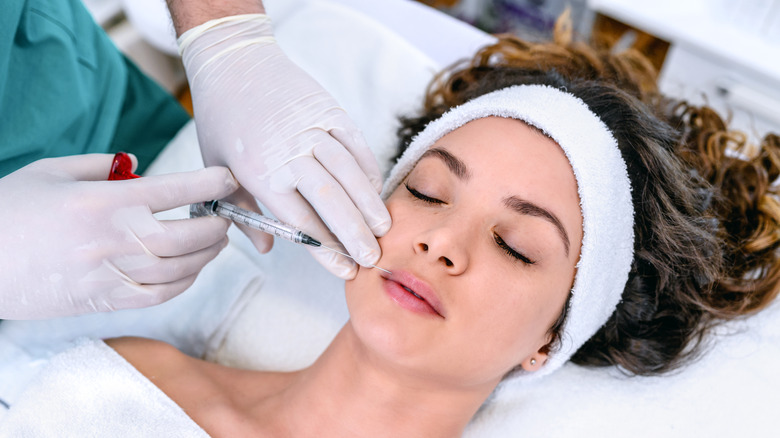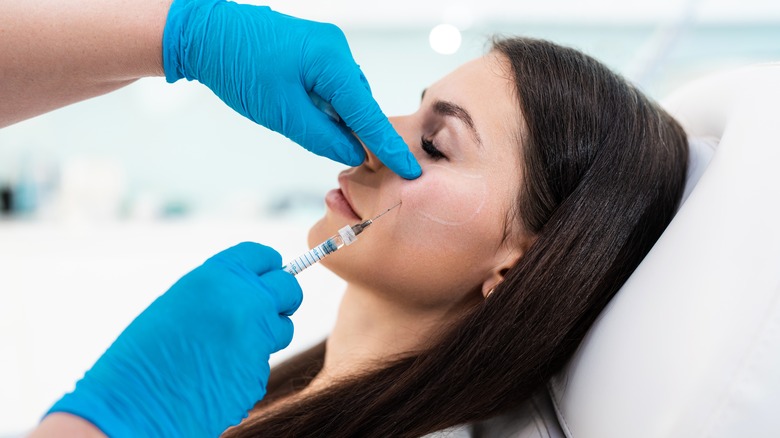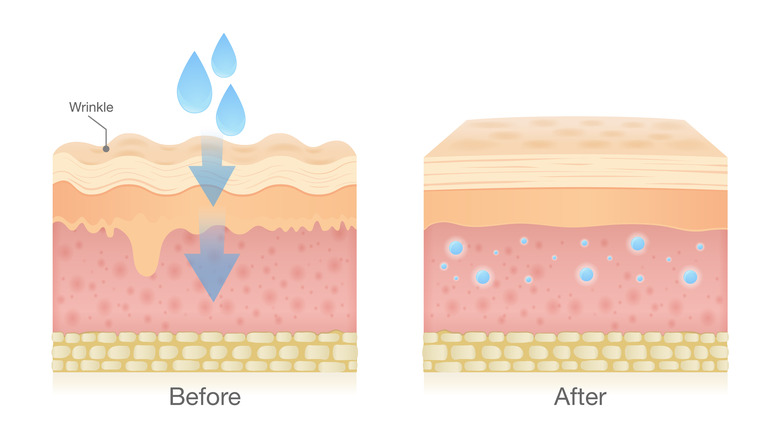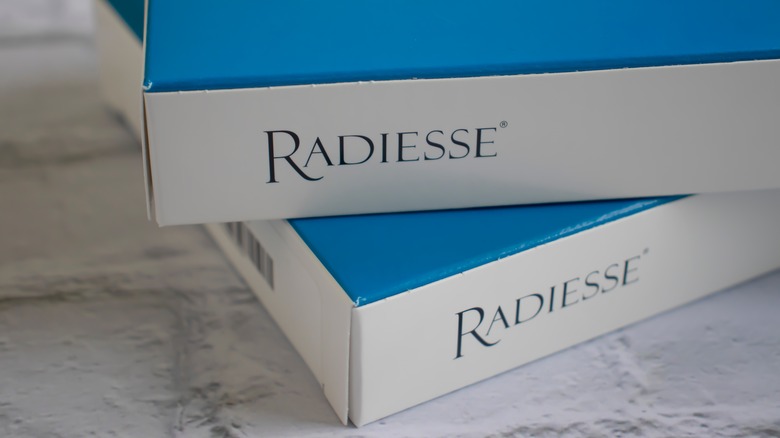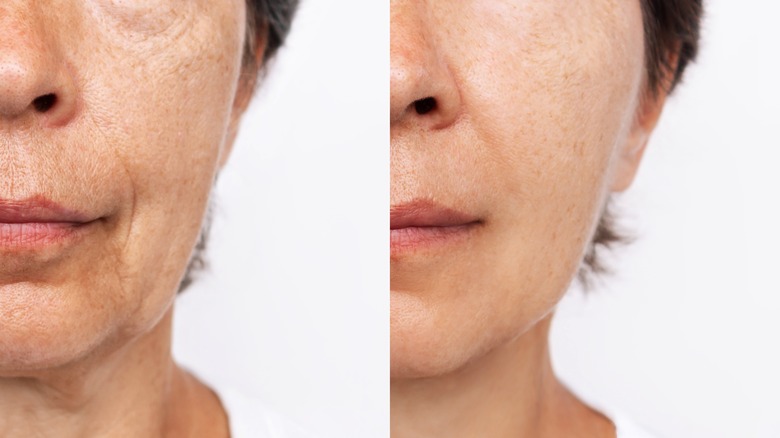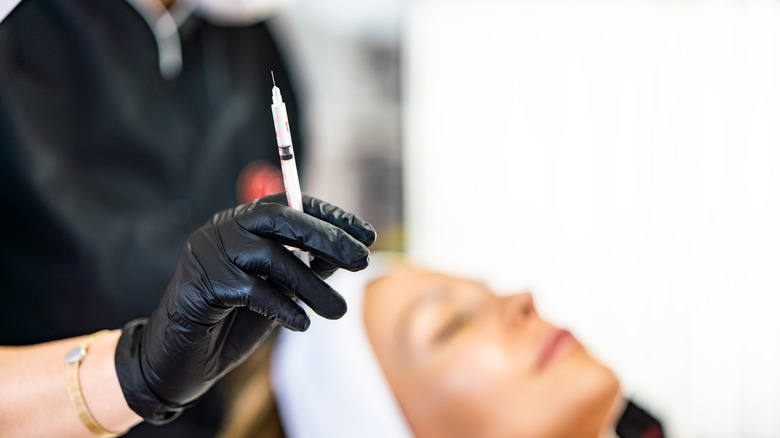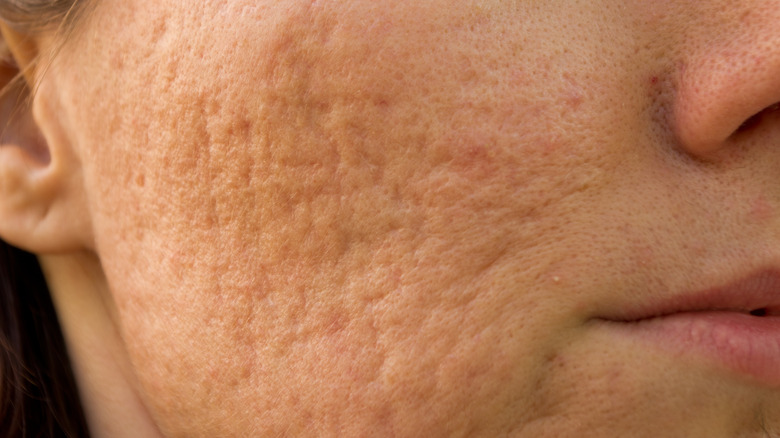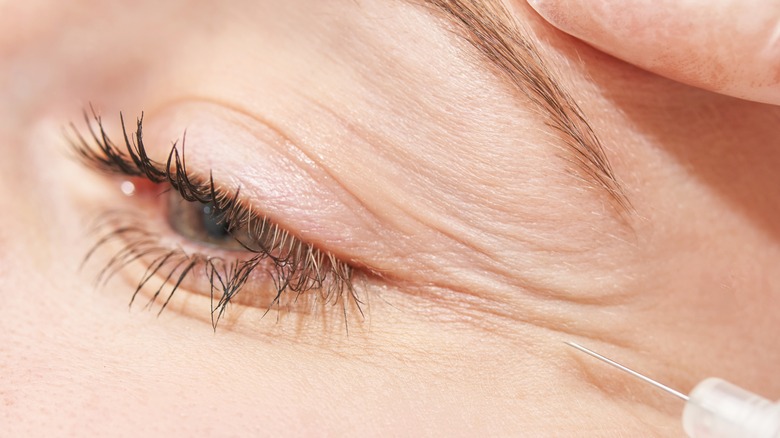Your Ultimate Guide To Understanding Every Type Of Dermal Fillers
For the uninitiated, dermal fillers are a type of injectable used under the skin. Their main purpose is to smooth out lines and reduce the appearance of wrinkles. The difference between Botox and fillers, as their name implies, is that they fill out recesses using various materials. For the most part, these materials get broken down over time by the body, where they can be safely absorbed, so their effects are temporary. Others that don't get absorbed are considered permanent.
Filler types are also differentiated by their size and how deeply they enter the skin. Some have smaller molecules that are better for the upper layers of the skin. For more severe skin sagging and deep-set wrinkles, the thicker molecule may be used to add more volume and restore the underlying tissues.
While only five out of the six dermal injections on this list are FDA-approved, all six of these injections are commonly found in the plastic surgery domain and are still in use abroad. However, even with approved dermals, there are risks involved. You should always discuss these in-depth with your medical provider to make sure that the procedure is right for you.
Hyaluronic acid fillers
Hyaluronic acid is made of a type of complex carbohydrate naturally found in the body's connective tissues. It's an acid that helps the skin retain moisture and can improve hydration. For these reasons, hyaluronic acid (HA) fillers are a popular choice for restoring volume to areas that typically lose water as we age, such as around the mouth, nose, under the eyes, cheeks, earlobes, and chin. Since it's made from a substance that can be broken down by the body, its effects are only temporary, lasting between six to 24 months, depending on the brand and where it's used (via the American Society of Dermatologic Surgery).
There are various types of HA fillers, but generally, they can be used to reduce the appearance of sagging skin, wrinkling, and fine lines on the hands and face. It's also possible to use them as a filler for plumping lips. They are applied in gel form and usually made synthetically from bacterial fermentation or animal sources, though the latter is less common due to issues with allergies. And depending on the depth of the area, and the patient's age, HA filler products can be foundational (used for deep recesses) or superficial (for fine lines and shallow wrinkles). The procedure is generally safe, but efficacy can vary depending on the brands (per research by International Journal of Molecular Sciences).
Types of hyaluronic acid fillers and how they compare
The main difference in HA fillers is how the molecules are arranged when synthesized. Different brands use various technologies, changing how the HA is linked together, and this changes their characteristics, such as how long they last, their viscosity, and their stability (per International Journal of Molecular Sciences). These technologies typically fall into three categories: Biphasic, monophasic monodensified, and monophasic polydensified. Monophasic fillers consist of heavy and lightweight molecules, giving them enhanced stability and durability.
Brands like Restylane and Restylane LYFT are biphasic, tend to be more viscous, and are more suited to superficial fillers. They also have less cohesion, so they don't last as long. Other brands like Juvederm, Bolotero, and Voluma are monophasic, so they're strongly bonded together and are less viscous. They last longer but don't spread well, so are more suited as foundational fillers (via Top Dermal).
The benefits and risks of hyaluronic acid fillers
One of the main benefits of hyaluronic acid fillers is they're made of substances naturally found in the body, so they have good biocompatibility compared to other injectables. According to Science Direct, this means that our bodies respond well to them without triggering an immune system response. They also last a reasonable amount of time, approximately three to 12 months, helping to reduce the appearance of wrinkles and targeting volume loss (i.e., giving more definition and shape) on the face. And another key advantage of HA fillers is that they can be easily removed if there are any issues (via research in the Plastic, Reconstructive & Aesthetic Surgery Journal).
However, this doesn't mean there are no risks from using HA fillers. Research shows that common reactions to dermal fillers include bruising, redness, or swelling. Serious reactions are rare, but infections can occur and cause tissue death and blocked blood vessels. These complications can be treated with hyaluronidase if caught early.
Surgeons who follow guidelines for proper use can generally provide safe treatment, but you should always check their licenses and references before scheduling a procedure (per the International Open Access Journal of the American Society of Plastic Surgeons).
Calcium hydroxylapatite (Radiesse) fillers
Calcium hydroxylapatite (CaHa) fillers, sometimes known by the brand name Radiesse, are derived from naturally occurring calcium-based minerals. Like HA, we naturally create this substance in our body's enamel and bone cells, though the type we find in fillers is artificially synthesized. It's used for filling out moderate to severe facial lines and folds, and can help with the appearance of volume loss, such as wrinkles and sagging. In these areas, CaHa is inserted in gel form, where it can fill out crevices under the skin for up to 18 months (via Top Dermal).
CaHA fillers are considered particularly effective in more serious cases because of their thickness as a filler medium. For instance, it can be used to help people who've suffered from facial fat loss, which sometimes happens with HIV, and can be used to target areas around the nose, mouth, and chin. But it's not suitable for in the lips or around the eyes (per the American Society for Dermatologic Surgery).
The benefits and risks of calcium hydroxylapatite fillers
Aside from CaHa fillers being used to add volume, they're also beneficial for their effects on rejuvenating the skin overall. For instance, research shows that CaHa can help stimulate collagen production and promote wound healing in the skin, helping to combat elasticity loss (via the Frontiers in Medicine Journal).
However, while CaHa is considered biocompatible and FDA-approved, there are risks. For instance, there have been several case studies that note rare vascular complications. These are when the dermal substance causes blockages within the blood vessels. However, unlike HA fillers, CaHa isn't as easy to remove if something goes wrong, presenting more risk than the former (in the Journal of Plastic and Aesthetic Research).
Another drawback of CaHa fillers is early and unexpected volume loss. In clinical research, it's shown that CaHa is generally safe and long-lasting but sometimes can be absorbed too quickly by the body before new collagen forms. To combat this, a mixture of CaHa in combination with hyaluronic acid is suggested, which has shown positive results and may become more widely used in the future (per the Journal of Craniofacial Surgery).
Polyalkylimide (Aquamid) fillers
Polyalkylimide, also known by the brand name Aquamid or Bio-Alcamid, is a type of semi-permanent dermal filler, meaning it isn't absorbed by the body. It's synthetically made from acrylic polymers but is minimally reactive and is considered biocompatible. Polyalkylimide fillers are typically used for deeper areas of volume loss on the face, such as wrinkling around the mouth, cheekbones, jaw, and for areas of severe scarring. And in some instances, it may be used for lip enhancements or in combination with HA to treat the appearance of minor wrinkling or fine lines (via the American Society of Plastic Surgeons).
Polyalkylimide fillers are considered non-toxic and safe for long-term use, especially for traumatic injuries, genetic facial defects, and HIV-related volume loss. However, due to several reports about infections from the gel medium used with this filler, it's not currently approved by the FDA (from "Botulinum Toxins, Fillers and Related Substances"). That said, it remains in use in other areas, such as the U.K., Europe, South America, and the Middle East, and is apparently under consideration for distribution in North America. However, we wouldn't advise seeking out a U.S. treatment for polyalkylimide fillers until it's formally approved.
The benefits and risks of polyalkylimide fillers
There are a few benefits to polyalkylimide fillers over other injectables aside from their general use. Namely, since there's little reaction to tissues (at least initially), you don't need to have an allergy test before getting the treatment. Additionally, unlike some fillers which can interfere with X-ray procedures, polyalkylimide won't obscure imaging (via the American Society of Plastic Surgeons).
The main issue is that since polyalkylimide fillers are designed to be permanent, they can often create issues in the long run. For instance, a paper in the Journal of Dermatologic Surgery presents cases where the fillers began to degrade over time. Several patients didn't know that the material had begun to deteriorate, only noticing that the effects weren't as prominent as before. The researchers suggest that even as the filler broke down, it didn't cause an immune system response in these patients. However, in others, an acute inflammatory response was seen around the filler site.
In one serious case presented in the American Pharmacists Association Journal, the polyalkylimide filler had migrated into the bloodstream, causing a clot. Although these outcomes may be rare, the risk of polyalkylimide filler seems to have been sufficient enough for it to be suppressed by the FDA.
Poly-l-lactic acid (Sculptra) fillers
Poly-l-lactic acid (PLLA), also known as Sculptra, is a type of non-permanent, synthetically made polymer filler that's been approved by the FDA for over 10 years. It's also biocompatible and broken down by the body over time into water and CO2 (via the American Society of Plastic Surgeons). However, unlike other temporary fillers, it degrades at a much faster rate and is often used repeatedly over a shorter period of time to obtain optimum results. It can begin to degrade in as little as six months, but once subsequent sessions are completed, it can last up to two years.
In general, PLLA fillers are generally thought of as safe and used to help those who've suffered loss of facial volume, though mostly they're used for superficial lines around the nose. At times, they're also used off-label as fillers for the glutes and chest and for reconstructive surgery, though these uses aren't approved by the FDA at the time of writing(via the National Health Institutes).
The benefits and risks of poly-l-lactic acid fillers
According to research, the main advantage of PLLA fillers is triggering collagen production. Although they have the same filling effect as others, they stimulate much more collagen than the likes of HA, so they're better designed for rejuvenation rather than skin contouring. Of course, they can improve the appearance of fine lines and wrinkles, but this isn't their primary purpose (in the Aesthetic Surgery Journal).
Infections and complications with PLLA fillers are rare when used correctly. The most common complaints are bruising, swelling, and redness, as with most other injections. However, it's important that patients aren't on any blood-thinning medications when opting for PLLA and that they follow post-treatment procedures to reduce the risk of complications.
Additionally, although this risk is low, you should keep in mind that, unlike other fillers, PLLA is designed to be used in small doses over time, having a cumulative effect. It isn't measured as other fillers are by their volume, since low-volume PLLA (i.e., the amount you get in one session) is thought to be safer and has an overall better effect (via the National Health Institutes).
Polymethyl-methacrylate microspheres (Bellafill) fillers
Polymethyl-methacrylate microspheres (PMMA) — also known as Bellafill, Artecoll, and MetaCrill — are a type of filler that uses acrylic-derived polymer beads suspended in a medium. The medium can vary but is usually a solution of cow's collagen or sometimes HA, depending on the brand. It's FDA-approved and biocompatible. However, the substance is permanent, i.e., not absorbable by the human body. It used to be used as cement for bone and joint replacement but has become a popular filler for tackling the appearance of deep wrinkles, frown lines, and facial recesses (via DermNet).
PMMA can be used in deep lines and folds around the mouth, forehead, eyes, and nose. It's commonly applied to help fill depressions left by acne scarring. However, because of the density and thickness of PMMA, it needs to be applied in small amounts over time. Like PLLA fillers, it's not measured strictly by volume, and multiple sessions may be needed to achieve the desired effects (via the American Society of Plastic Surgeons).
The benefits and risks of PMMA fillers
A great benefit of PMMA fillers is that their medium of delivery is collagen. And collagen, being a structural protein that provides elasticity and strength to the skin, means that the PMMA filler can have lasting positive effects. Like other fillers, research shows they also stimulate the body's own collagen production and wound healing response, which can help to maintain its effects (per the Journal of Dermatologic Surgery). However, there are some risks.
Studies on PMMA safety show that in some cases, the filler can damage tissues and cause blood clotting, particularly when it's used in high doses. However, when they compared PMMA to HA fillers, they actually found they posed less risk ( per the Aesthetic Plastic Surgery Journal).
In fact, a good deal of research suggests that overall, PMMA is a safe filler option with minimal downtime, good efficacy, and satisfactory results. However, complications still happen. About one in every 2,075 patients develops granulomas, which are an immune response. Further, most studies on PMMA have only conducted follow-ups after one to five years, but since it's a permanent filler, there may be some long-term risks we aren't yet aware of (in the Aesthetic Plastic Surgery Journal).
Fat fillers
Fat fillers, also referred to as fat grafting or transfer, are a category of their own. This is because the medium has to be harvested before it can be reinjected elsewhere. Typically, this might be the stomach or buttocks. If several dermal injections are needed, the procedure may need to be repeated. Once the extracted fat has been treated, it can be used to restore volume to areas of the face and used to fill areas of wrinkling or folds (via the American Society of Plastic Surgeons).
Per Stanford Medicine, it can be used to help areas around the eyes, cheeks, and chin whilst still being a step down from artificial implants (though it's still considered a surgical procedure). People often take fat from an area where they don't want it and use this fat in the filler.
As you might have guessed, it's a particularly biocompatible procedure when carried out correctly, and the fat will be naturally reabsorbed by the body over time. However, according to research, this can cause some issues as the rate of absorption can be unpredictable (in the Seminars in Plastic Surgery Journal).
The benefits and risks of fat fillers
The effects of fat fillers have been touted for their ability to replace volume because it uses the body's own resources. They may even slow some of the factors related to aging, such as loss of elasticity, as fat cells have been shown to have some stimulatory effects on growth proteins in the skin cells. This can aid in overall facial rejuvenation, with effects lasting up to two years (per the Aesthetic Surgery Journal).
But while reviews indicate that such treatments fall under the FDA's approved guidelines, there remain some concerns over possible surgical complications, the proliferation of damaged cells that can get transferred inadvertently, and the risk of fat absorption later on down the line. While the fat is intended to be reabsorbed by the body in the long run, if it's absorbed too quickly, it can actually result in aggravating the appearance of volume loss.
However, most people appear satisfied with the results of this procedure, as there is a satisfaction rate of 91%. But many surgeons suggest that, on the whole, it works better when combined with other treatments (via the Seminars in Plastic Surgery Journal).
